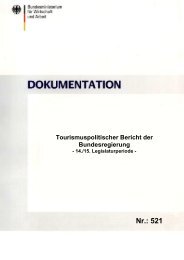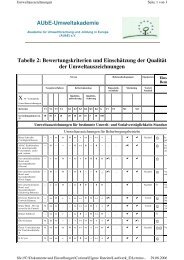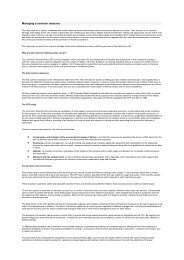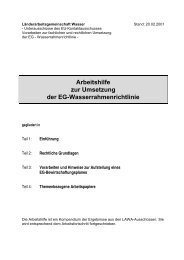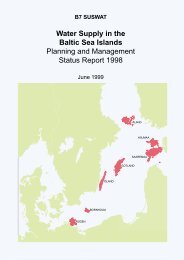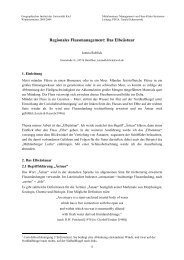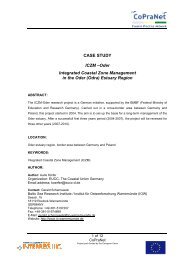The European environment - State and outlook ... - IKZM-D Lernen
The European environment - State and outlook ... - IKZM-D Lernen
The European environment - State and outlook ... - IKZM-D Lernen
You also want an ePaper? Increase the reach of your titles
YUMPU automatically turns print PDFs into web optimized ePapers that Google loves.
Introduction<br />
improvements to Europe's <strong>environment</strong>, economy<br />
<strong>and</strong> overall quality of life in the face of changing<br />
demographics.<br />
<strong>The</strong> assessment for Part A is written in a more accessible<br />
style <strong>and</strong> as such is targeted to an informed political<br />
<strong>and</strong> public audience working mainly outside the<br />
<strong>environment</strong> sphere but for whom <strong>environment</strong>al<br />
concerns play a role in their day-to-day activities <strong>and</strong><br />
decision-making. Examples include politicians <strong>and</strong><br />
policy-makers working in the economic sectors that<br />
have most influence on the <strong>environment</strong> — agriculture,<br />
transport, industry, tourism <strong>and</strong> trade; the financial<br />
community, where <strong>environment</strong>al issues are of<br />
increasing relevance to decisions around insurance risk<br />
<strong>and</strong> investment choices; the research <strong>and</strong> development<br />
community, which would be the source of many of the<br />
innovations that could contribute to reducing future<br />
<strong>environment</strong>al pressures <strong>and</strong> impacts; <strong>and</strong> the informed<br />
public. All of these groups have an interest in how<br />
Europe's <strong>environment</strong> is developing, from the local<br />
through to the global level, <strong>and</strong> in how <strong>environment</strong>ally<br />
motivated integrated approaches can help improve<br />
<strong>European</strong> <strong>environment</strong>s, economies <strong>and</strong> societies.<br />
Part B<br />
Part B of the report presents a first detailed assessment<br />
at the <strong>European</strong> level that uses the 37 EEA/Eionet<br />
core set of indicators which were agreed with EEA's<br />
stakeholders in March 2004. <strong>The</strong> core set was selected<br />
to provide a stable basis for indicator-based reporting<br />
by EEA <strong>and</strong> others in Europe (e.g. the <strong>European</strong><br />
Commission) <strong>and</strong> to provide a focus for prioritising<br />
improvements in data quality.<br />
<strong>The</strong> core set includes selected indicators relevant to<br />
the main <strong>environment</strong>al problems — air pollution <strong>and</strong><br />
ozone depletion, climate change, biodiversity, waste,<br />
terrestrial <strong>environment</strong> <strong>and</strong> water — as well as main<br />
economic sectors — agriculture, transport, energy<br />
<strong>and</strong> fisheries. Other relevant priority areas (chemicals,<br />
noise, material flows, industry <strong>and</strong> household sectors)<br />
have not yet been included in the core set, which<br />
reflects the lack of sufficient data <strong>and</strong> methodological<br />
development. <strong>The</strong>se areas will be the main focus for<br />
future work on the core set.<br />
All of the indicators in the core set are relevant to the<br />
assessments presented in Part A of the report. <strong>The</strong><br />
bibliography section at the end of each chapter in Part<br />
A provides a check-list of relevant indicators. While<br />
there is some repetition in the use of analysis <strong>and</strong><br />
graphs from Part B into Part A, in the vast majority<br />
of cases every effort has been made to avoid such<br />
overlaps. <strong>The</strong> main exception concerns the soil chapter<br />
which has drawn extensively on the core set because of<br />
the relative paucity of good quality data <strong>and</strong> analysis<br />
for this issue.<br />
Each indicator is presented in a st<strong>and</strong>ard four-page<br />
template that includes information on policy questions<br />
<strong>and</strong> messages, trends assessment, data quality <strong>and</strong><br />
methodological developments. <strong>The</strong> four pages are<br />
summaries of more detailed indicator profiles that are<br />
available on the EEA website.<br />
<strong>The</strong> assessments for each indicator are written in a<br />
more technical language <strong>and</strong> as such are targeted at a<br />
more informed audience working on, or interested in,<br />
<strong>environment</strong>al issues, or for those who want to have<br />
more in-depth information about these issues after<br />
reading relevant chapters of Part A.<br />
Part C<br />
Part C of the report provides a more detailed country<br />
level analysis of progress on <strong>environment</strong>al issues<br />
using a scorecard based on nine indicators from the 37<br />
in the core set. Since the scorecard aims to give insights<br />
into progress with <strong>environment</strong>al performance, the<br />
nine indicators relate to points that policy can affect<br />
<strong>and</strong> on which policy is targeted. Thus, most of the<br />
indicators either have specific policy targets associated<br />
with them that allow analysis of progress towards these<br />
targets, or aspirational targets that allow for a similar<br />
though less definitive analysis. <strong>The</strong>se indicators also<br />
have data available at the country level with trends<br />
covering a sufficient number of years to enable robust<br />
analysis of change.<br />
<strong>The</strong> nine indicators are relevant to main policy<br />
priorities in the <strong>environment</strong> <strong>and</strong> in the economic<br />
sectors that have most impact. <strong>The</strong>y are: greenhouse<br />
gas emissions <strong>and</strong> removals, total energy consumption<br />
12<br />
<strong>The</strong> <strong>European</strong> <strong>environment</strong> | <strong>State</strong> <strong>and</strong> <strong>outlook</strong> 2005



